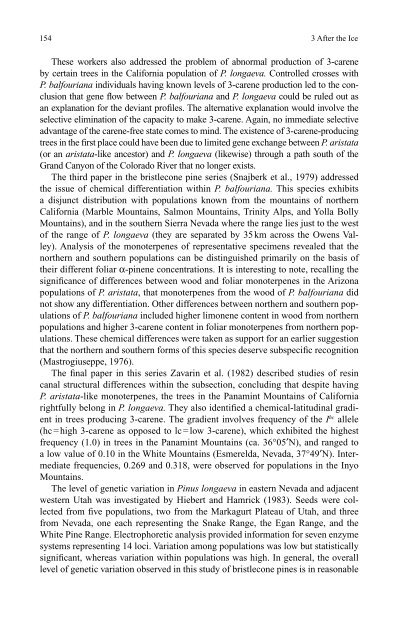The Geography of Phytochemical Races
The Geography of Phytochemical Races
The Geography of Phytochemical Races
Create successful ePaper yourself
Turn your PDF publications into a flip-book with our unique Google optimized e-Paper software.
154 3 After the Ice<br />
<strong>The</strong>se workers also addressed the problem <strong>of</strong> abnormal production <strong>of</strong> 3-carene<br />
by certain trees in the California population <strong>of</strong> P. longaeva. Controlled crosses with<br />
P. balfouriana individuals having known levels <strong>of</strong> 3-carene production led to the conclusion<br />
that gene fl ow between P. balfouriana and P. longaeva could be ruled out as<br />
an explanation for the deviant pr<strong>of</strong>i les. <strong>The</strong> alternative explanation would involve the<br />
selective elimination <strong>of</strong> the capacity to make 3-carene. Again, no immediate selective<br />
advantage <strong>of</strong> the carene-free state comes to mind. <strong>The</strong> existence <strong>of</strong> 3-carene-producing<br />
trees in the fi rst place could have been due to limited gene exchange between P. aristata<br />
(or an aristata-like ancestor) and P. longaeva (likewise) through a path south <strong>of</strong> the<br />
Grand Canyon <strong>of</strong> the Colorado River that no longer exists.<br />
<strong>The</strong> third paper in the bristlecone pine series (Snajberk et al., 1979) addressed<br />
the issue <strong>of</strong> chemical differentiation within P. balfouriana. This species exhibits<br />
a disjunct distribution with populations known from the mountains <strong>of</strong> northern<br />
California (Marble Mountains, Salmon Mountains, Trinity Alps, and Yolla Bolly<br />
Mountains), and in the southern Sierra Nevada where the range lies just to the west<br />
<strong>of</strong> the range <strong>of</strong> P. longaeva (they are separated by 35 km across the Owens Valley).<br />
Analysis <strong>of</strong> the monoterpenes <strong>of</strong> representative specimens revealed that the<br />
northern and southern populations can be distinguished primarily on the basis <strong>of</strong><br />
their different foliar α-pinene concentrations. It is interesting to note, recalling the<br />
signifi cance <strong>of</strong> differences between wood and foliar monoterpenes in the Arizona<br />
populations <strong>of</strong> P. aristata, that monoterpenes from the wood <strong>of</strong> P. balfouriana did<br />
not show any differentiation. Other differences between northern and southern populations<br />
<strong>of</strong> P. balfouriana included higher limonene content in wood from northern<br />
populations and higher 3-carene content in foliar monoterpenes from northern populations.<br />
<strong>The</strong>se chemical differences were taken as support for an earlier suggestion<br />
that the northern and southern forms <strong>of</strong> this species deserve subspecifi c recognition<br />
( Mastrogiuseppe, 1976).<br />
<strong>The</strong> fi nal paper in this series Zavarin et al. (1982) described studies <strong>of</strong> resin<br />
canal structural differences within the subsection, concluding that despite having<br />
P. aristata-like monoterpenes, the trees in the Panamint Mountains <strong>of</strong> California<br />
rightfully belong in P. longaeva. <strong>The</strong>y also identifi ed a chemical-latitudinal gradient<br />
in trees producing 3-carene. <strong>The</strong> gradient involves frequency <strong>of</strong> the I hc allele<br />
(hc = high 3-carene as opposed to lc = low 3-carene), which exhibited the highest<br />
frequency (1.0) in trees in the Panamint Mountains (ca. 36°05′N), and ranged to<br />
a low value <strong>of</strong> 0.10 in the White Mountains (Esmerelda, Nevada, 37°49′N). Intermediate<br />
frequencies, 0.269 and 0.318, were observed for populations in the Inyo<br />
Mountains.<br />
<strong>The</strong> level <strong>of</strong> genetic variation in Pinus longaeva in eastern Nevada and adjacent<br />
western Utah was investigated by Hiebert and Hamrick (1983). Seeds were collected<br />
from fi ve populations, two from the Markagurt Plateau <strong>of</strong> Utah, and three<br />
from Nevada, one each representing the Snake Range, the Egan Range, and the<br />
White Pine Range. Electrophoretic analysis provided information for seven enzyme<br />
systems representing 14 loci. Variation among populations was low but statistically<br />
signifi cant, whereas variation within populations was high. In general, the overall<br />
level <strong>of</strong> genetic variation observed in this study <strong>of</strong> bristlecone pines is in reasonable
















